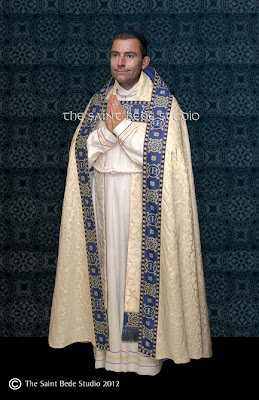
Frequently I am asked about chasubles in the
Borromeon Form. The
Borromeon form is not defined by any particular decorative style, but
by its size. Saint Charles set down measurements which he regarded as
necessary for a chasuble to conform with Tradition.
In a pointed remark in the comment box of a well-known Blog, it was suggested that the term
Borromeon has been invented by the Saint Bede Studio as a marketing strategy. Whilst I concede that it has become more commonly used in recent years, it is certainly a legitimate adjective used to describe a vestment according to S' Charles' stipulations. My earliest discovery of the use of this adjective dates from the year 1926, being the authoritative English monograph of Raymond James
The Origin and Development of Roman Liturgical Vestments.
In
this post, I wish to discuss a famous statue of Saint Philip Neri in
the sacristy of the church of Santa Maria in Vallicella, Rome. This
marvellous 3-metre tall statue was completed in 1638 by the famed
Italian sculptor Alessandro Algardi.
Attached is a
digitally-enhanced photograph of the statue. I emphasise that this
enhancement is NOT intended to depict actual colours or decoration. It
is intended to show more clearly the form and decoration of the chasuble
that Algardi sculpted.
This is a chasuble in the Roman
tradition. It is very long at the back, reaching almost the full
length of the alb; at the front it is slightly shorter. It has a curved
shape, rather than being squared-off at the bottom. Note that the
chasuble falls gracefully over the body, indicating that it is not
interlined to stiffen it, as chasubles were of the later Baroque period.
It largely corresponds to dimensions set down by Saint Charles
Borromeo (whilst Archbishop of Milan 1560-1584), but it is slightly
narrower, since as sculpted it falls only slightly beyond the elbow,
rather than approaching the wrist (which was recommended by Saint Charles).
Very prominent on
the chasuble is the massive tau, with adjoining panels supporting the
neckline. Almost certainly, the rear of the chasuble would have been
ornamented with a single column. These ornaments are formed from a
floral scrollwork damask, outlined with a galloon (probably 3cm wide).
In
terms of studying the history of the development of the chasuble, this
statue is most significant. It is important to note that the statue was
sculpted within the living memory of Saint Philip (he died in 1595).
And yet, it reflects a style of chasuble found in the first quarter of
the 17th century.
 |
| Painting of a Solemn Mass, shewing the celebrant in a very ample Borromeon chasuble. |
Several paintings exist of Saint
Philip, and his contemporary Saint Ignatius Loyola, shewing them in
sacred vestments. Many of these artworks, however, were painted long
after the deaths of Neri and Loyola, even a century later. As such, it
cannot be asserted that the chasubles depicted in these later paintings
necessarily reveal the style of chasuble of the late 16th and early 17th
centuries. They depict vestments of the late 17th and early 18th
centuries, by which time it was common that the width of the chasuble
was less ample and it had begun to be interlined to stiffen it.
And
yet, let us also remember this. Saint Charles set down dimensions for
the chasuble out of a desire to prevent its form being cut back in a
manner he considered inconsistent with Sacred Tradition. His intention was not to specify a form of vestment which was the most
comfortable to wear or which was aesthetically the most attractive, for these are very subjective matters. TRADITION was the cornerstone of Saint Charles' regulations.
It would be
foolish of us to imagine, however, that his instructions were adhered to
strictly, or even widely known. As a result, in this period of the
history of the chasuble (say, the century between 1550 and 1650),
several different styles of chasuble would have been extant, some longer
and wider than others. The width of the woven fabrics would also have
determined, to some extent, the width of the chasuble, to say nothing of
the personal taste and preferences of priests, bishops and the
vestment-makers themselves.

To
illustrate, I also attach one of the two famous painting of Saint
Ignatius by Rubens. Even though it was painted at much the same time as
the Algardi statue was sculpted, it depicts a completely different
style of chasuble. It is much narrower and stiffened with interlining
to support the lavish embroidery: most assuredly not a “Borromeon”
chasuble.
A word on the albs in the two pictures. Both
a very ample, falling to the ground in graceful folds. The sleeves are
extremely long but, since the cuffs fit the wrist so snugly, the
sleeves do not fall over the hands. The close-fitting sleeve is most
appropriate to these styles of chasuble. The alb in the statue of S’
Philip is trimmed with a small amount of lace.
One of the chasubles frequently worn by Pope Benedict is
almost identical in shape and dimensions with the famous statue of Saint
Philip Neri shewn above. The green Papal chasuble shewn in the photographs below conforms closely with the dimensions set down
by Saint Charles. It also happens to be decorated with a very narrow form of the TAU.
Click on each of the images below for an
enlarged view.
 The Saint Bede Studio was commissioned by Saint Mary's, Help of Christians Parish, Aiken (Diocese of Charleston, South Carolina), to prepare a Solemn Mass set of vestments
based upon the Maria Regina design.
The Saint Bede Studio was commissioned by Saint Mary's, Help of Christians Parish, Aiken (Diocese of Charleston, South Carolina), to prepare a Solemn Mass set of vestments
based upon the Maria Regina design.














